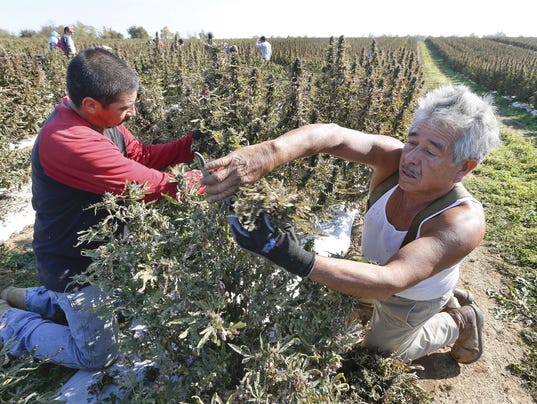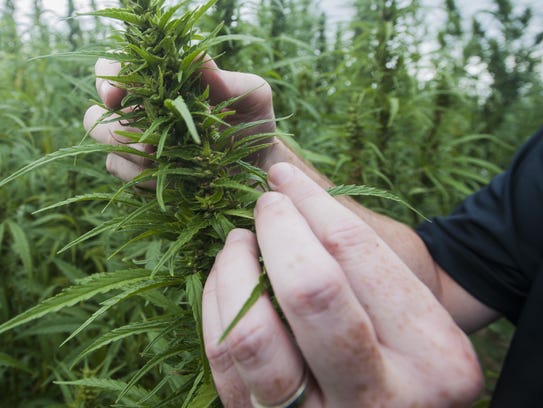Source: pressconnects.com
Hemp seen as a potentially valuable addition to New York's crop mix but it has a long way to go and market uncertainties remain.

Farmers in the Southern Tier and elsewhere in New York may be able to legally grow a version of the marijuana plant for the first time in decades as early as the coming spring.

The Coloradoan Library A Colorado State University graduate research assistant handles a plant during a tour of a nearly half-acre test plot with 17 hemp varieties on Aug. 27. Brian Campbell, a Colorado State University graduate research assistant who helped design and execute the experiment, handles a plant during a tour of the nearly half acre test plot with 17 hemp varieties, Thursday, Aug. 27, 2015, in northern Colorado. (Photo: Morgan Spiehs/The Coloradoan)
The state Department of Agriculture and Markets has developed proposed regulations to govern experimental growing of a cultivar of cannabis, the plant most known today as the source of marijuana. Industrial hemp, as it’s sometimes known, has too little of the active ingredient tetrahydrocannabinol, often referred to as THC, to produce a recreational high yet is seen as having enormous potential.
Hemp has edible and oil-producing seeds, and its fibrous bark and internal core can be used as a building material. Parts of the plant are used in making plastics, paper, insulation, animal bedding and cosmetics, eaten and burned as biomass fuel. It also provides a chemical seen as having medical potential.
Two state lawmakers from the Southern Tier sponsored bills to get trial plantings started: Assemblywoman Donna Lupardo, D-Endwell, and Sen. Tom O'Mara, R-Elmira.
“We are on the frontier of a major new industrial crop, and that’s why I’ve been pushing New York to get out in front of it,” Lupardo said.
Federal law was changed in the 2014 national farm-policy bill to allow states to permit hemp research. Lupardo and O’Mara sponsored bills in New York to do just that. The measure was adopted with near-unanimous support, but rules governing the experiments were not adopted in time for the 2015 growing season.
Up to 10 projects will be allowed in 2016 in the state. They likely will consist of trials to see what varieties of Cannibas sativa, as the plant is known formally, will do best for seed, oil and fiber production, said Jerry Cherny, the E.V. Baker Professor of Agriculture at Cornell University.
It’s unclear if Cornell’s College of Agriculture and Life Sciences will be involved in 2016 because there has been no funding budgeted for CALS hemp trials to date, Cherny said.
Twenty states have legislation allowing farmers to grow hemp or allowing experimental growing, according to Cherney, but Colorado and Kentucky are by far the farthest along. Kentucky, in particular, is developing a hemp industry already. It was the major hemp growing state, raising it for textile fiber primarily, in the early 20th century.
Kentucky farmers are finding hemp is a good replacement for tobacco, a major cash crop there, said Susan Cody, president of the New York Hemp Industries Association, and a Madison County farmer.
Hemp has appeal and potential for many reasons, according to Cody. It’s fairly easy to grow, and its leaves, stem and seed have many uses.
“The seed can be harvested and you can either save that for next year’s planting or people eat it and you can either shell it or eat it unshelled,” Cody said. “It’s high in omega threes and people will press it into oil and those are used for cosmetics, and people eat that, too, the oil. When you press it into oil you get a hemp meal and sometimes you can make that an animal feed a supplement for animal feed or people will make a protein powder out of it.”
The thick, woody internal stem can be combined with a binder to form blocks used as a building material. Hemp can be made into paper, its essential oils and seeds go into cosmetics, lip balm and hand cream; the car maker BMW uses it for floor mats and event door parts.
The plant has a very long tap root and can pull nutrients from deep in the soil, helping to replenish fields used for more common commodity crops like corn and soy beans. Used this way, it can also help fend off insect and fungal diseases that feed on repeated plantings of the same crops.
“It’s really kind of a huge potential here for people to specialize in certain strands and certain varieties and we’re really just kind of tip of the iceberg at this point,” Cody said.
The challenge will be to find varieties that are suited to the climate, soils and growing techniques, and to set up processing facilities, Cody said.
Legal resistance tied to the intoxicating variety of the plant remain. Initial rules required barbed-wire fencing around test parcels, which would be impractical and costly, Lupardo said. Those were eventually removed, however.
The rules the state Department of Agriculture and Markets made and published in the state register Sept. 30 require test hemp not contain more than .3 percent THC, the high-inducing ingredient, and that samples be tested at an approved lab. Any plants with more than that are to be destroyed, harvested plants have to be kept in and transported under security. Only institutions of higher education can apply for the permits, but they can contract with growers.
In Vermont, some farmers have been planting hemp using supposedly sterile food seeds, according to Rob Manfredi, a small farmer who advocates for the crop in that state. His small sustainability-oriented vegetable farm near Killington took seven pounds of food seeds and despite a 5 percent germination rate produced at least 40 pounds of seed in a season. The plan is to gradually build a seed supply system for farmers without them having to get federal narcotics licenses to have hemp seed.
Vermont farmers have to register with the state agriculture agency to grow hemp, he said. It’s no panacea for the rural economy in the Northeast, but hemp can have a role for growers willing to experiment, he said.
“I don’t think we look at this as the end all be all savior to humanity at all,” Manfredi said. “It’s a strong big part of the picture for getting the small farmers back to work.”
The market may be an obstacle, too. Canada is farther ahead in developing its hemp industry.
In the U.S., as states open to hemp, oversupply may become a problem, as happened in Canada at first, though its market recovered from a price crash and is stable and growing, according to Cherney.
“Most of the world’s hemp is grown in China, with extremely cheap labor, and they would be happy to supply an expanded market,” he said.
Still, hemp is seen as a crop worth trying. Lupardo said a chemical component is being researched for treating medical and psychiatric disorders and is of interest at the Binghamton University School of Pharmacy.
“I got an email from a local entrepreneur yesterday. He sent me research about hemp as a phyoto-remdiation plant. You can plant it in contaminated soil. And it extracts pollution from soil.”
“There’s also applications for hemp for battery storage believe it or not. it’s the most remarkable plant in terms of multi-use.”
The proposed rules were published in the State Register Sept. 30. The comment period ended a month later, and Ag and Markets expects to publish the final rules before the end of the year.
No comments:
Post a Comment